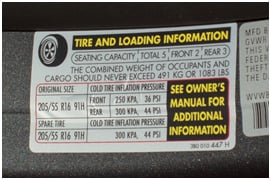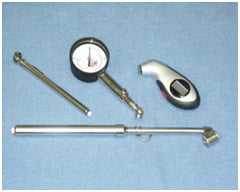Driving on tires with improper inflation pressure is dangerous.
- Underinflation causes excessive heat buildup and internal structural damage.
- Overinflation makes it more likely for tires to be cut, punctured, or broken by sudden impact.
These situations can cause a tire failure, including tread/belt separation, even at a later date, which could lead to an accident and serious personal injury or death.
Consult the vehicle’s tire placard, certification label, or the owner's manual for the recommended inflation pressures.
The pressure indicated on the tire sidewall is the maximum allowed in the tire, irrespective of the vehicle. Follow the vehicle manufacturer's recommendations for inflation pressure found on the vehicle’s tire placard, certification label, or in the owner's manual.
Whether inflated with air or nitrogen, regular inflation pressure maintenance remains critical and necessary. Use of nitrogen alone is not a replacement for regular inflation pressure maintenance.

